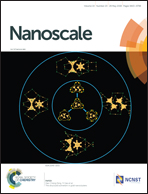Ni-core CuO-shell fibers produced by electrospinning and electroplating as efficient photocathode materials for solar water splitting†
Abstract
Charge recombination in CuO photocathodes inhibits efficient electron flow and limits the photo-electrochemical performance of these cathodes for solar water splitting. To circumvent this shortcoming, we introduce highly conductive Ni/CuO core–shell structured fibers. The photocurrent density (PCD) achieved with these core–shell fibers exceeded that of fibers without a Ni core by a factor of 2.6. The PCD enhancement arises from increased acceptor concentration and electron–hole recombination time, as measured by electrochemical impedance spectroscopy. These core–shell nanofibers were fabricated via electrospinning and electroplating. First, a polyacrylonitrile fiber was electrospun and then seeded with metal via sputtering. Second, electroplating was used to encase and metalize the fiber with Ni and Cu. Finally, the outermost Cu shell was oxidized to CuO, which is an effective photocathode for solar water splitting. The Ni–CuO, core–shell layers were characterized by scanning electron microscopy, elemental mapping, X-ray diffraction, and X-ray photoelectron spectroscopy. The core Ni content and number of core–shell fibers per area were optimized through parametric studies.



 Please wait while we load your content...
Please wait while we load your content...